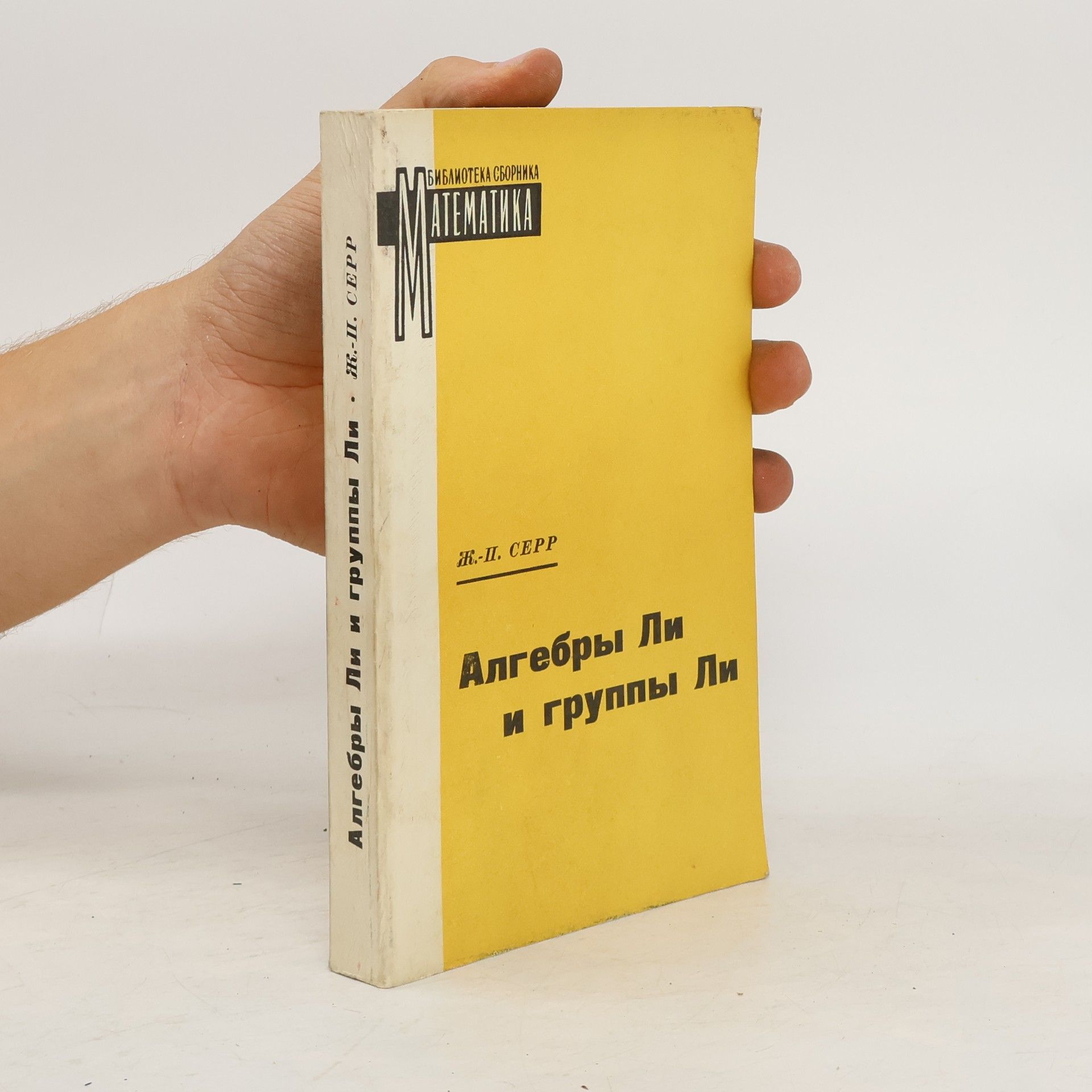The seminal ideas of this book played a key role in the development of group theory since the 70s. Several generations of mathematicians learned geometric ideas in group theory from this book. In it, the author proves the fundamental theorem for the special cases of free groups and tree products before dealing with the proof of the general case. This new edition is ideal for graduate students and researchers in algebra, geometry and topology.
Jean-Pierre Serre Bücher
Jean-Pierre Serre war ein wegweisender Mathematiker, dessen Arbeit die algebraische Topologie, algebraische Geometrie und Zahlentheorie maßgeblich prägte. Er zeichnete sich durch die Einführung fortschrittlicher Techniken wie Garbentheorie und homologischer Algebra in neue mathematische Bereiche aus. Seine frühen Arbeiten zur Topologie und mehreren komplexen Variablen legten den Grundstein für zukünftige Entdeckungen. Später verlagerte Serre seinen Schwerpunkt auf die Zahlentheorie und Galois-Darstellungen, wo seine Erkenntnisse das Feld weiterhin beeinflussen.






Local Fields
- 256 Seiten
- 9 Lesestunden
Focusing on local class field theory, this book explores the subject from a cohomological perspective, building on the methodologies of Hochschild and Artin-Tate. It delves into extensions of local fields, particularly abelian ones, and is structured into four parts. The initial sections cover foundational concepts of discrete valuation rings and Dedekind domains, followed by an examination of ramification phenomena. The text emphasizes the norm map within this framework, using additive and multiplicative polynomials for clarity, while maintaining accessibility for readers familiar with basic algebra and topology.
These short notes, already well-known in their original French edition, present the basic theory of semisimple Lie algebras over the complex numbers. The author begins with a summary of the general properties of nilpotent, solvable, and semisimple Lie algebras. Subsequent chapters introduce Cartan subalgebras, root systems, and linear representations. The last chapter discusses the connection between Lie algebras, complex groups and compact groups. The book is intended to guide the reader towards further study.
The present book is an English translation of Algebre Locale - Multiplicites published by Springer-Verlag as no. 11 of the Lecture Notes series. The original text was based on a set of lectures, given at the College de France in 1957-1958, and written up by Pierre Gabriel. Its aim was to give a short account of Commutative Algebra, with emphasis on the following topics: a) Modules (as opposed to Rings, which were thought to be the only subject of Commutative Algebra, before the emergence of sheaf theory in the 1950s); b) H omological methods, a la Cartan-Eilenberg; c) Intersection multiplicities, viewed as Euler-Poincare characteristics. The English translation, done with great care by Chee Whye Chin, differs from the original in the following aspects: - The terminology has been brought up to date (e. g. „cohomological dimension“ has been replaced by the now customary „depth“). I have rewritten a few proofs and clarified (or so I hope) a few more. - A section on graded algebras has been added (App. III to Chap. IV). - New references have been given, especially to other books on Commu- tive Algebra: Bourbaki (whose Chap. X has now appeared, after a 40-year wait) , Eisenbud, Matsumura, Roberts, .... I hope that these changes will make the text easier to read, without changing its informal „Lecture Notes“ character.
The book is based on a course given by J.-P. Serre at the College de France in 1980 and 1981. Basic techniques in Diophantine geometry are covered, such as heights, the Mordell-Weil theorem, Siegel's and Baker's theorems, Hilbert's irreducibility theorem, and the large sieve. Included are applications to, for example, Mordell's conjecture, the construction of Galois extensions, and the classical class number 1 problem. Comprehensive bibliographical references."
This is an updated English translation of COHOMOLOGIE GALOISIENNE published more than 30 years ago, as one of the very first Lecture Notes in Mathematics. It includes a reproduction of an influential paper of R. Steinberg, together with some new material and an expanded bibliography.
The main general theorems on Lie Algebras are covered, roughly the content of Bourbaki's Chapter I. I have added some results on free Lie algebras, which are useful, both for Lie's theory itself (Campbell-Hausdorff formula) and for applications to pro-Jrgroups. of time prevented me from including the more precise theory of Lack semisimple Lie algebras (roots, weights, etc.); but, at least, I have given, as a last Chapter, the typical case ofal,.. This part has been written with the help of F.Raggi and J.Tate. I want to thank them, and also Sue Golan, who did the typing for both parts. Jean-Pierre Serre Harvard, Fall 1964 Chapter I. Lie Definition and Examples Let Ie be a commutativering with unit element, and let A be a k-module, then A is said to be a Ie-algebra if there is given a k-bilinear map A x A~ A (i.e., a k-homomorphism A0" A -+ A). As usual we may define left, right and two-sided ideals and therefore quo tients. Definition 1. A Lie algebra over Ie isan algebrawith the following 1). The map A0i A -+ A admits a factorization A ®i A -+ A2A -+ A i.e., ifwe denote the imageof(x,y) under this map by [x,y) then the condition becomes for all x e k. [x,x)=0 2). (lx,II], z]+ny, z), x) + ([z,xl, til = 0 (Jacobi's identity) The condition 1) implies [x,1/]=-[1/,x).
Les nouvelles affaires criminelles du Cantal
- 377 Seiten
- 14 Lesestunden
Après une première descente dans les arcanes de la criminalité cantalienne, Christian Estève et Jean-Pierre Serre récidivent avec Les Nouvelles Affaires Criminelles du Cantal. Du Consulat à la Ve République, ils font resurgir non seulement la noirceur et la violence d'une société où bâton, poison et fusil servent, bien souvent, à régler tant les problèmes familiaux que ceux du voisinage, mais également la quotidienneté d'une vie de tout un peuple dont la parole ne nous est parvenue que par la voie judiciaire. De la Châtaigneraie, où rôdent encore les ombres des assassins de la châtelaine de Maurs, et la menette de Saint-Constant aux plateaux de l'Artense et du Limon, où cohabitent, parfois difficilement, bêtes et hommes, vachers et propriétaires, en passant par la vallée de la Jordanne, qui résonne des cris de fou d'un jeune parricide autour de Saint-Rémy de Lascelle ou des sanglots du berger infirme dont la défense contre la brutalité d'un maître vacher entraîne le père au bagne, c'est tout un monde de petites gens que misère, étroitesse d'esprit, envie ou haines ancestrales ont conduites devant la justice qui nous apparaît...


